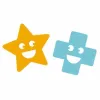Take a look inside 11 images
DoodleMaths
Pros: Kids can improve skills and confidence with straightforward lessons and positive reinforcement.
Cons: Short explanations leave out concept-building, and missing lessons leave gaps.
Bottom Line: A good, adaptive program that can be used to support a growth mindset along with strong math skills.
Teachers will find the DoodleMaths setup process for classes and student accounts quick, with multiple methods like using class codes or copying and pasting from Excel or Word for bulk uploads. Each teacher's dashboard includes the ability to monitor student data, view gap analysis, and assign additional activities. A key feature is the ability to message students, parents, and teachers and keep everyone informed. In this section, teachers can also view messages sent between students to be sure students are safely interacting with one another.
While the daily practice questions are automatically generated, teachers can assign an Extra lesson from a bank that covers many standards, or even make their own set of questions unique to their students' needs. Teachers should encourage students to write their own problems and include them in a classwide Extra assignment. The My Doodles feature has great potential: Students can create and save their own explanations or notes to create an online notebook and track their understanding. There's an option to change the background paper to scenes like a mountain, a park, or outer space. Given a topic and a scene, the class can be challenged to write their own math questions. The Tricky Questions section is a great conversation starter for math circles: In small groups, students can share which problems they're struggling with and see, collectively, how the group can solve the problem.
DoodleMaths is an interactive and adaptive learning program (based on the national U.K. curriculum) for strengthening old math skills and learning new ones. The first time in the program, students take a short calibration quiz. This data is used to generate "4/5/6/7 a Day" practice questions. If a practice problem becomes tricky, students have ways to find help. These options include taking a hint, reading or listening to a written explanation, and, in some cases, saving the question to a list of Tricky Questions, which is later reviewed with an adult. This is the only way for students to review questions, as they cannot go back and review questions missed or see previous question sets.
Not only do students have access to a magnifying glass to zoom in on any part of the screen, as well as a Doodle Pad that acts as virtual scratch paper, but each question and explanation can also be read out loud. There's also a toolkit for selected questions with useful items like protractors and rulers.
As students correctly answer questions and play games, they earn stars, which are exchanged to build customizable cartoon robots. Each student account also includes a section called My Pages. In this section, students are able to find their robots, access doodle pages, view their progress, and, if enabled by the teacher, message friends.
Positive language and help along the way create a safe environment for learning with DoodleMaths, and students will be kept on their toes with a variety of question styles. While skill games and building cool robots with earned rewards are engaging, these types of activities are limited and most likely won't become a distraction.
DoodleMaths adapts practice questions to keep students challenged, but also allows teachers the flexibility to redirect students by assigning Extra skills unique to their learning needs. Although there are standards that currently don't have a lesson available, teachers can create their own sets of multiple-choice questions. The provided lessons and explanations are clear and concise, making it easy for students to take in smaller bits of information; however, short explanations can result in surface-level understanding. To ensure deeper understanding, teachers should be ready to supplement these lessons during class time with strategies that build conceptual understanding. Teachers should also be aware that the text-to-speech feature is very robotic and can -- at times -- misread mathematical problems.



















